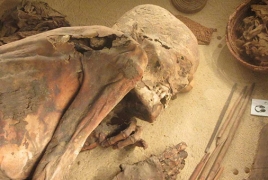Prehistoric mummy reveals incredible embalming salve August 17, 2018 - 13:24 AMT PanARMENIAN.Net - The Turin mummy, or “Fred,” as it has become known to archaeologists, has been housed in Turin's Egyptian Museum since the early 1900s and remained unstudied by scientists. Dating to 3,600 years ago and curled in the fetal position, the mummy was first thought to have been “created by chance” but new evidence suggested to scientists that the Turin mummy was no accident, Ancient Origin says. A study published on Thursday, August 16 in the Journal of Archaeological Science is the accumulation of a decade of work focused on prehistoric mummies by the study’s co-author Jana Jones , an Egyptologist at Macquarie University. Her team successfully tested the mummy and found a complex list of ingredients used during the embalming process, and Jones told reporters “the salve had a base of plant oils that was then mixed with plant gum or sugars, heated conifer resin, and aromatic plant extracts” according to an article in National Geographic. This particular list of ingredients is causing such a stir because it’s the earliest known Egyptian embalming salve. However, it is remarkably similar to the later salves used on deceased nobles and their perceived journeys into the afterlife. Speaking about this observation, the components of the paste, said Jones, “not only resemble those used thousands of years later in Egypt, but they also bear a striking similarity to the chemistry of the salve researchers had identified in the prehistoric mummy wrappings.” Stuart Tyson Smith , an archaeologist from the University of California, Santa Barbara, who was not part of the study team, told reporters “It's really interesting to see those connections and it gives us a nice piece of the puzzle that we didn't have before.” Previously it was thought that the mummification of the older mummies has occurred naturally due to the dry climate and sand. But now we know even the most ancient Egyptian dead had a little helping human hand to slow the aging process. Jones first peered at the wrappings under a microscope almost 10 years ago and she "was astounded” to find the “cloths appeared to contain remnants of an embalming resin, a compound commonly seen in later mummies.” “It was just an incredible feeling” she said. However, to actually prove that Egyptians embalmed their dead thousands of years earlier than previously thought, almost a decade of chemistry oriented projects was undertaken. According to an article in PHYS.org "By combining chemical analysis with visual examination of the body, genetic investigations, radiocarbon dating and microscopic analysis of the linen wrappings, we confirmed that this ritual mummification process took place around 3600 BC on a male, aged between 20 and 30 years when he died,” said Jones. Authorities said a total of 192 Azerbaijani troops were killed and 511 were wounded during Azerbaijan’s offensive. In 2023, the Azerbaijani government will increase the country’s defense budget by more than 1.1 billion manats ($650 million). The bill, published on Monday, is designed to "eliminate the shortcomings of an unreasonably broad interpretation of the key concept of "compatriot". The earthquake caused a temporary blackout, damaged many buildings and closed a number of rural roads. Partner news |